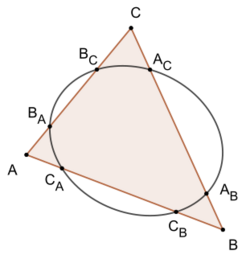Carnot's theorem (conics)
From HandWiki
Short description: A relation between conic sections and triangles
Carnot's theorem (named after Lazare Carnot) describes a relation between conic sections and triangles.
In a triangle [math]\displaystyle{ ABC }[/math] with points [math]\displaystyle{ C_A, C_B }[/math] on the side [math]\displaystyle{ AB }[/math], [math]\displaystyle{ A_B, A_C }[/math] on the side [math]\displaystyle{ BC }[/math] and [math]\displaystyle{ B_C, B_A }[/math] on the side [math]\displaystyle{ AC }[/math] those six points are located on a common conic section if and only if the following equation holds:
- [math]\displaystyle{ \frac{|AC_A|}{|BC_A|}\cdot \frac{|AC_B|}{|BC_B|}\cdot \frac{|BA_B|}{|CA_B|}\cdot \frac{|BA_C|}{|CA_C|} \cdot \frac{|CB_C|}{|AB_C|}\cdot \frac{|CB_A|}{|AB_A|}=1 }[/math].
References
- Huub P.M. van Kempen: On Some Theorems of Poncelet and Carnot. Forum Geometricorum, Volume 6 (2006), pp. 229–234.
- Lorenz Halbeisen, Norbert Hungerbühler, Juan Läuchli: Mit harmonischen Verhältnissen zu Kegelschnitten: Perlen der klassischen Geometrie. Springer 2016, ISBN:9783662530344, pp. 40, 168–173 (German)
External links
- Carnot's theorem
- Carnot's Theorem for Conics at cut-the-knot.org


